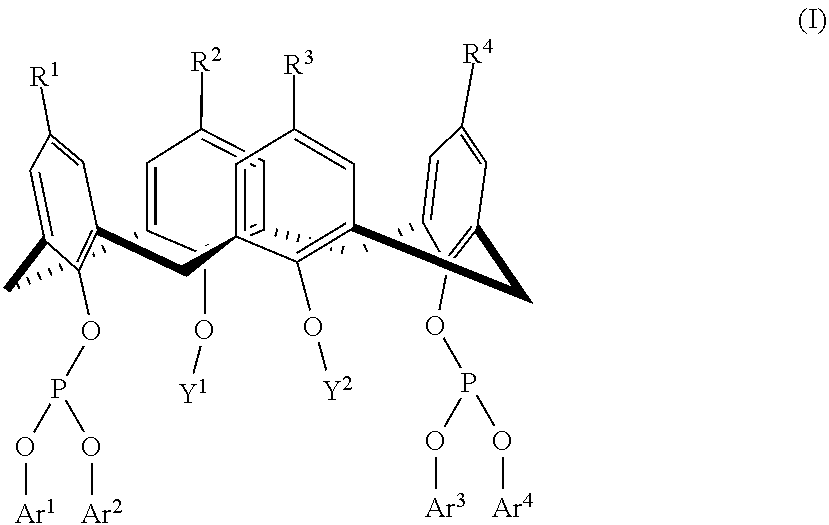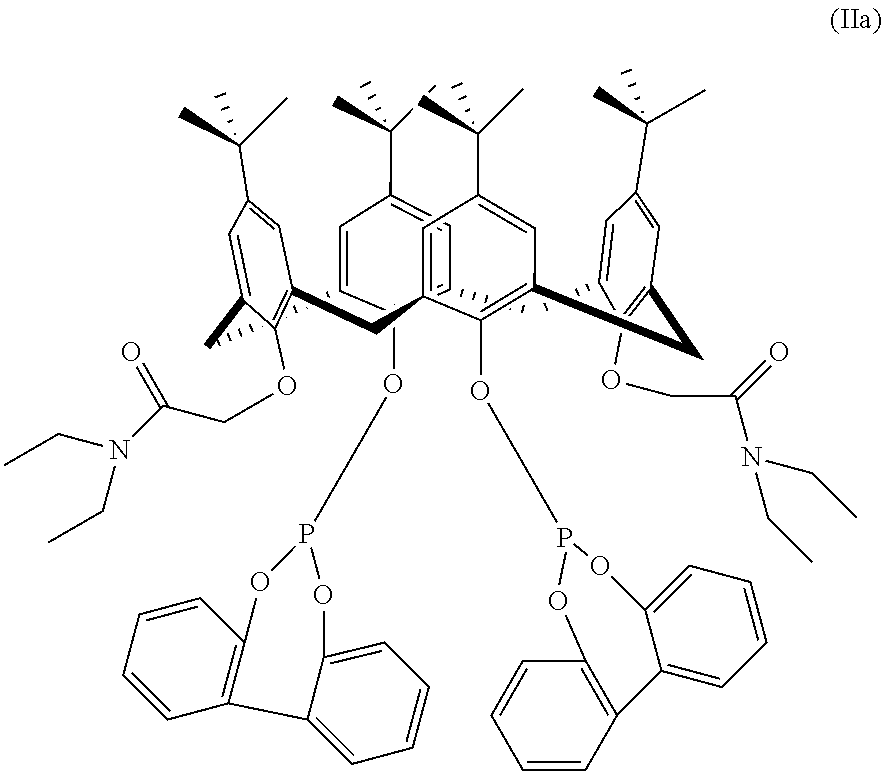Hydroformylation process
a technology of hydroformylation and hydrogen ion, which is applied in the direction of physical/chemical process catalysts, organic compounds/hydrides/coordination complexes catalysts, other chemical processes, etc., can solve the problem that the n/i of rhodium/tpp catalysts cannot be increased, and the normal to iso-aldehyde product ratio is limited to about a 10:1 ratio, so as to achieve an acceptable reaction rate and high n/i ratio ratio
- Summary
- Abstract
- Description
- Claims
- Application Information
AI Technical Summary
Benefits of technology
Problems solved by technology
Method used
Image
Examples
examples 1-4
[0053]A rhodium catalyst precursor (dicarbonylacetylacetonato rhodium (I) (150 ppm rhodium), triphenylphosphine (TPP) (300 equivalents TPP / Rh, 10.3 wt %) and the N,N-diethylacetamide-p-tert-butylcalix [4] arene bisphosphite ligand (DE-Calix-BP, 0, 1, 2 and 3 equivalents / Rh) are weighed into a septum-capped bottle in a dry box. The solids are dissolved in toluene, and the resulting solution transferred via vacuum into a 100 ml Parr mini-reactor. The catalyst-containing solution is then preheated with agitation (1100 rpm) to 90° C. under 1:1 carbon monoxide:hydrogen (syngas) for 30 minutes. A pressure of 60 psig 1:1:1 gas (equal parts carbon monoxide:hydrogen:propylene) is established with a Brooks model 5866 flow meter, and held constant for a run time of 2 hours. Total gas uptake is measured with a Brooks 0151E totalizer. Liquid reaction samples are taken periodically and analyzed on an Agilent Technologies 6890 Gas Chromatograph (GC), equipped with a DB-1 30m×0.32 mm, 1μ film colum...
examples 5-8
[0055]The procedure of examples 1-4 is repeated, except for the following changes to concentrations and conditions: 300 ppm rhodium, thus changing the concentration of TPP / Rh to 150 equivalents TPP / Rh, 4.7 g propylene added as a liquid, and 80 psig 1:1 carbon monoxide: hydrogen at 90° C. The results for a range of 0-3 equivalents per rhodium of DE-Calix-BP appear below:
[0056]
ExampleDE / Calix-BP (L / Rh)Initial Rate (g mol / I-hr)Final N / I 5*03.123.4611.285.5721.0010.4830.6713.3*Not an embodiment of the invention
examples 9-12
[0057]The procedure of examples 1-4 is repeated, except for the following changes to concentrations and conditions: 300 ppm rhodium, thus changing the concentration of TPP / Rh to 150 equivalents TPP / Rh, 5.5 g 1-butene added as a liquid, and 40 psig 1:1 carbon monoxide: hydrogen at 100° C. The results for a range of 0-3 equivalents per rhodium of DE-Calix-BP appear below:
[0058]
ExampleDE / Calix-BP (L / Rh)Initial Rate (g mol / I-hr)Final N / I 9*03.056.01011.619.11120.8616.31230.7824.5*Not an embodiment of the invention
Comparative Experiments 13-16 (Not an Embodiment of the Invention)
[0059]The procedure of examples 9-12 is repeated, but instead of the calixarene bisphosphite ligand of the invention, Ligand B (pictured below) is used:
[0060]
The results for a range of 0-3 equivalents per rhodium of Ligand B appear below:
[0061]
ExampleDE / Calix-BP (L / Rh)Initial Rate (g mol / I-hr)Final N / I13*04.616.014*12.046.515*20.0981.516*30.0885.7*Not an embodiment of the invention
[0062]Examples 2-4 surprisingly ...
PUM
| Property | Measurement | Unit |
|---|---|---|
| reaction rate | aaaaa | aaaaa |
| partial pressure | aaaaa | aaaaa |
| temperature | aaaaa | aaaaa |
Abstract
Description
Claims
Application Information
 Login to View More
Login to View More - R&D
- Intellectual Property
- Life Sciences
- Materials
- Tech Scout
- Unparalleled Data Quality
- Higher Quality Content
- 60% Fewer Hallucinations
Browse by: Latest US Patents, China's latest patents, Technical Efficacy Thesaurus, Application Domain, Technology Topic, Popular Technical Reports.
© 2025 PatSnap. All rights reserved.Legal|Privacy policy|Modern Slavery Act Transparency Statement|Sitemap|About US| Contact US: help@patsnap.com



